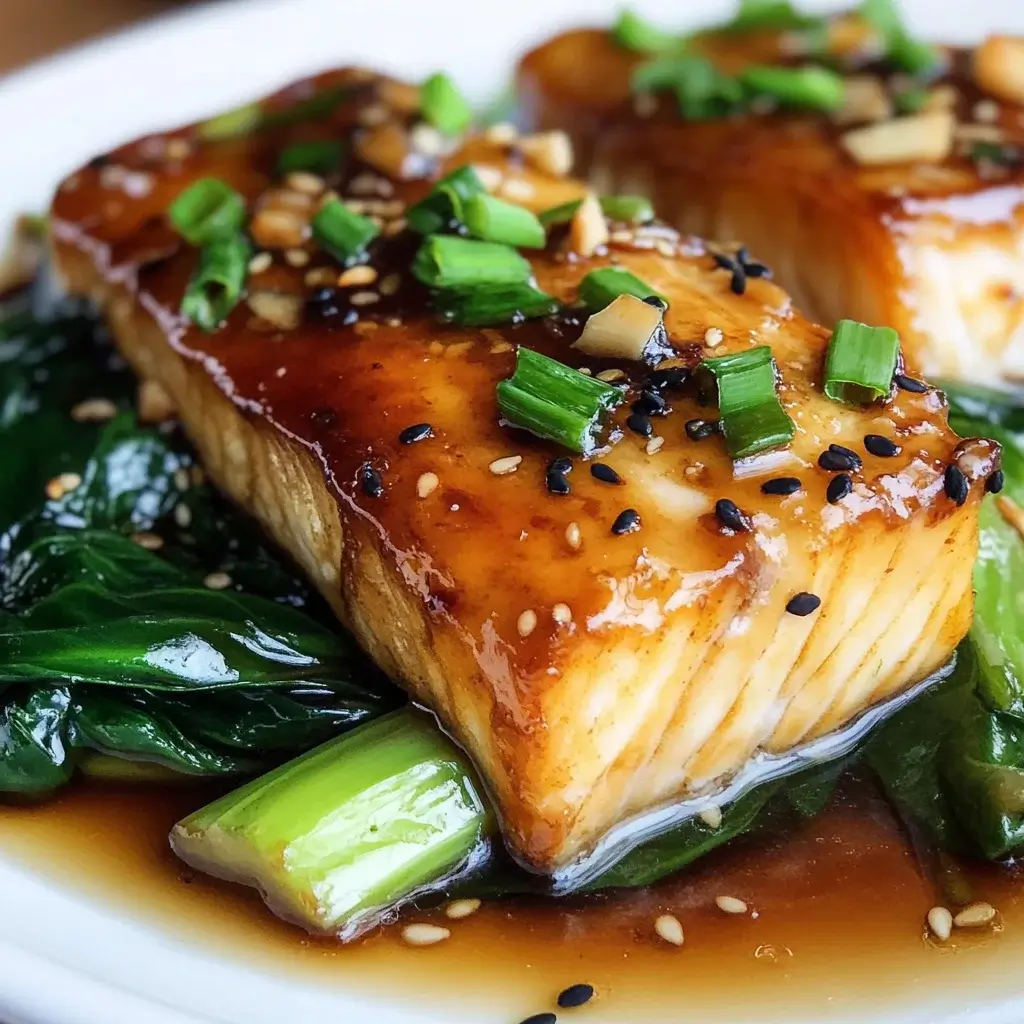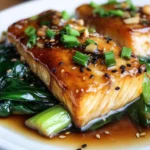It was one of those Tuesday evenings – the kind where energy is low, but the craving for something truly delicious and nourishing is high. My family, usually a mix of picky eaters and discerning palates, was looking to me for a culinary miracle. I remembered a recipe I’d been wanting to try, one that promised a symphony of savory, sweet, and umami notes with minimal fuss: Miso Glazed Fish with Bok Choy. Skepticism was in the air, especially from my youngest, who eyes anything green with suspicion. But as the aroma of the caramelizing miso glaze and toasting sesame oil began to fill the kitchen, a curious silence descended. The first bite was revelatory. The fish, flaky and tender, was perfectly complemented by the slightly sweet, deeply savory miso glaze. The bok choy, wilted yet still retaining a pleasant crunch, provided a fresh counterpoint. Miraculously, even the resident vegetable critic asked for seconds! This Miso Glazed Fish with Bok Choy recipe has since become a treasured staple in our home, a testament to how simple ingredients, thoughtfully combined, can create a truly memorable and satisfying meal. It’s elegant enough for guests, yet quick enough for a weeknight, proving that healthy eating can be an absolute joy.
Ingredients
Here’s what you’ll need to create this delightful Miso Glazed Fish with Bok Choy:
- For the Miso Glaze:
- 1/4 cup (60ml) white miso paste: Provides a salty, savory, and slightly sweet umami base. White miso (Shiro Miso) is milder and sweeter than red miso, making it excellent for glazes.
- 2 tablespoons mirin: A sweet Japanese rice wine that adds a subtle sweetness and helps create a glossy glaze.
- 1 tablespoon sake (Japanese rice wine) or dry white wine: Adds depth of flavor and helps to tenderize the fish. If unavailable, you can use a little extra mirin or rice vinegar.
- 1 tablespoon soy sauce (or tamari for gluten-free): Contributes saltiness and umami, deepening the overall flavor profile.
- 1 tablespoon maple syrup or honey: Adds a touch of sweetness to balance the miso and helps with caramelization.
- 1 teaspoon grated fresh ginger: Imparts a warm, zesty kick that brightens the glaze.
- 1 teaspoon sesame oil: Adds a distinctive nutty aroma and flavor, quintessential to many Asian dishes.
- For the Fish and Bok Choy:
- 4 (6-ounce / 170g each) firm white fish fillets: Such as cod, halibut, sea bass, or even salmon. Skin-on or skinless, about 1-1.5 inches thick.
- 1 tablespoon neutral cooking oil: Like avocado oil or grapeseed oil, for searing the fish and cooking the bok choy.
- 1 pound (450g) baby bok choy or regular bok choy: Baby bok choy can be halved or quartered; larger bok choy should have leaves separated and stems sliced.
- 2 cloves garlic, minced: Adds an aromatic base for cooking the bok choy.
- 1 teaspoon sesame seeds (toasted, optional for garnish): Adds a nutty crunch and visual appeal.
- Sliced green onions (optional for garnish): Provides a fresh, mild oniony bite and color.
- Salt and freshly ground black pepper: To taste, for seasoning the fish and bok choy.
Instructions
Follow these steps carefully to achieve a perfectly cooked Miso Glazed Fish with tender-crisp Bok Choy:
- Prepare the Miso Glaze:
In a small bowl, whisk together the white miso paste, mirin, sake (or white wine), soy sauce (or tamari), maple syrup (or honey), grated ginger, and sesame oil until smooth. Set aside. If your miso paste is particularly thick, you might need to whisk vigorously or even gently warm the mixture slightly to help it combine. The consistency should be like a thick sauce, easily spreadable. - Marinate the Fish (Optional but Recommended):
Pat the fish fillets completely dry with paper towels. This is crucial for achieving a good sear and allowing the glaze to adhere properly. Season the fish lightly with salt and pepper on both sides. Place the fish fillets in a shallow dish or a resealable plastic bag. Pour about two-thirds of the miso glaze over the fish, ensuring each fillet is well-coated. Reserve the remaining one-third of the glaze for later. Allow the fish to marinate in the refrigerator for at least 30 minutes, or up to 2 hours for a deeper flavor. If you’re short on time, even 15 minutes will make a difference. Avoid marinating delicate white fish for too long, as the salt in the miso can start to “cook” it (like ceviche) and alter its texture. - Prepare the Bok Choy:
While the fish is marinating (if you chose to), prepare the bok choy. If using baby bok choy, trim the ends and halve or quarter them lengthwise, depending on their size. If using larger bok choy, separate the leaves from the stems. Slice the thicker white stems into 1/2-inch pieces and roughly chop the green leaves. Rinse thoroughly under cold water to remove any grit, then pat dry or use a salad spinner. - Cook the Fish:
There are two excellent methods for cooking the fish: pan-searing then baking, or broiling.- Pan-Sear then Bake Method (Recommended for thicker fillets):
Preheat your oven to 400°F (200°C). Heat 1 tablespoon of neutral cooking oil in a large oven-safe skillet (cast iron is ideal) over medium-high heat until shimmering. Carefully place the marinated fish fillets in the hot skillet, ensuring not to overcrowd the pan (cook in batches if necessary). Sear for 2-3 minutes per side, until golden brown and slightly caramelized. Be gentle when flipping to keep the fillets intact.
Transfer the skillet to the preheated oven. Bake for 8-12 minutes, or until the fish is cooked through and flakes easily with a fork. The internal temperature should reach 145°F (63°C). During the last 2-3 minutes of baking, you can brush the fish with some of the reserved miso glaze for an extra layer of flavor and gloss. - Broiling Method (Good for thinner fillets or achieving more char):
Position an oven rack about 6 inches from the broiler element and preheat the broiler to high. Line a baking sheet with parchment paper or aluminum foil (for easier cleanup). Place the marinated fish fillets on the prepared baking sheet. Broil for 5-8 minutes, watching very closely as the glaze can burn quickly due to its sugar content. The fish is done when it’s opaque, flakes easily, and the glaze is bubbly and lightly charred in spots. You may want to brush with additional reserved glaze halfway through broiling.
- Pan-Sear then Bake Method (Recommended for thicker fillets):
- Cook the Bok Choy (while fish is baking/broiling or resting):
While the fish is in its final stages of cooking or resting, prepare the bok choy. In a large skillet or wok, heat the remaining 1/2 tablespoon of neutral oil (if needed, some fat may remain from searing the fish) over medium-high heat. Add the minced garlic and cook for about 30 seconds until fragrant, being careful not to burn it.
Add the bok choy stems (if you separated them) and cook for 2-3 minutes, stirring occasionally, until they begin to soften. Then, add the bok choy leaves and continue to cook, stirring frequently, for another 2-4 minutes, or until the leaves are wilted and the stems are tender-crisp. You can add a tablespoon of water or a splash of the remaining miso glaze to the pan to help steam the bok choy if it seems too dry. Season lightly with salt and pepper, if desired (remember the glaze is already salty). - Glaze and Serve:
Once the fish is cooked, carefully remove it from the oven or skillet. If you have any reserved miso glaze left, gently warm it and brush it over the hot fish fillets for an extra burst of flavor and a beautiful sheen.
To serve, arrange a portion of the cooked bok choy on each plate. Place a miso-glazed fish fillet alongside or on top of the bok choy. Garnish with toasted sesame seeds and sliced green onions, if using. Serve immediately while hot.
Nutrition Facts
This Miso Glazed Fish with Bok Choy is not only delicious but also packs a healthy punch.
- Servings: 4
- Calories per serving: Approximately 350-450 calories (This can vary significantly based on the type and size of fish fillet used, and whether honey or maple syrup is chosen).
Here are some key nutritional highlights:
- High in Protein: Primarily from the fish, protein is essential for muscle repair, immune function, and satiety, keeping you fuller for longer. A typical 6oz cod fillet provides around 30-35g of protein.
- Rich in Omega-3 Fatty Acids (especially if using salmon or other fatty fish): These healthy fats are crucial for brain health, reducing inflammation, and supporting cardiovascular health.
- Excellent Source of Vitamins and Minerals: Bok choy contributes significant amounts of Vitamin C (immune support), Vitamin K (bone health, blood clotting), Vitamin A (vision, skin health), and folate. Fish provides B vitamins and minerals like selenium and phosphorus.
- Good Source of Fiber: Bok choy provides dietary fiber, which aids digestion, helps regulate blood sugar levels, and contributes to a feeling of fullness.
- Relatively Low in Carbohydrates: Making it a suitable option for those watching their carbohydrate intake, especially when served without high-carb sides like rice.
Preparation Time
Understanding the time commitment helps in planning your meal efficiently.
- Active Preparation Time: Approximately 20-25 minutes. This includes making the glaze, preparing the fish for marination, and chopping the bok choy and garlic.
- Marinating Time: 30 minutes to 2 hours (optional, but highly recommended for best flavor). If you skip marinating, the active prep time is shorter, but the flavor infusion won’t be as deep.
- Cooking Time: Approximately 15-25 minutes. This includes searing/baking or broiling the fish (10-15 minutes) and sautéing the bok choy (5-7 minutes).
- Total Time (including 30 min marination): Roughly 1 hour to 1 hour 15 minutes. If you skip the marination or opt for a very short one, total time can be under 45 minutes.
This recipe is well-suited for a flavorful weeknight dinner if you marinate the fish ahead of time or opt for a shorter marination period.
How to Serve
This Miso Glazed Fish with Bok Choy is wonderfully versatile. Here are some serving suggestions to complete your meal:
- Classic & Simple:
- Serve the fish and bok choy over a bed of fluffy steamed white or brown rice. The rice will soak up any extra glaze beautifully. Jasmine or Basmati rice are excellent choices.
- For a nuttier, more wholesome option, try quinoa or farro.
- Noodle Pairings:
- Alongside soba noodles (buckwheat noodles) tossed with a light sesame-ginger dressing.
- With simple udon noodles in a light broth.
- Low-Carb Options:
- Serve with cauliflower rice for a low-carb, grain-free meal.
- Pair with a larger portion of steamed or roasted mixed vegetables, such as broccoli, snap peas, or bell peppers.
- Garnishes & Extras:
- Always sprinkle with toasted sesame seeds for crunch and nutty flavor.
- Add thinly sliced green onions or chives for a fresh, sharp contrast.
- A small wedge of lime or lemon on the side can add a bright, acidic counterpoint if desired.
- For a bit of heat, offer a small dish of sriracha or a sprinkle of red pepper flakes.
- Presentation:
- Arrange the bok choy neatly on the plate, creating a vibrant green bed for the fish.
- Drizzle any remaining warm glaze attractively over the fish and onto the plate.
- Consider serving family-style on a large platter if entertaining.
Additional Tips
Elevate your Miso Glazed Fish with Bok Choy experience with these expert tips:
- Choosing Your Miso: While white miso (Shiro Miso) is recommended for its mildness and sweetness, you can experiment. Red miso (Aka Miso) has a stronger, saltier, and more pungent flavor; use it sparingly or mix it with white miso if you prefer a bolder taste. Awase miso, a mix of red and white, is another good option.
- Fish Selection Matters: This glaze works well with many types of fish. Cod, halibut, and sea bass are great firm white fish options. Salmon, with its richer flavor and higher fat content, is also fantastic with miso glaze. Even mahi-mahi or snapper would be delicious. Ensure fillets are of similar thickness for even cooking.
- Don’t Over-Marinate: Especially for delicate white fish, marinating for too long (more than a few hours) can cause the fish to become too salty or change its texture due to the enzymatic action of miso and the acidity of other ingredients. 30 minutes to 2 hours is generally optimal.
- Achieve the Perfect Sear: Patting the fish thoroughly dry before adding the glaze and searing is key. A dry surface allows for better browning and caramelization. Don’t overcrowd the pan, as this will lower the temperature and cause the fish to steam rather than sear.
- Watch for Burning: Miso glaze contains sugars (from mirin, maple syrup/honey, and the miso itself) which can burn easily, especially under the broiler. Keep a close eye on the fish during the last few minutes of cooking. If it’s browning too quickly, you can lower the oven temperature or move the fish to a lower rack.
- Bok Choy Cooking Technique: For the best texture, cook the bok choy stems first as they take longer to soften, then add the leaves towards the end so they wilt but don’t become mushy. A quick stir-fry over high heat helps retain its crispness and vibrant color.
- Make-Ahead Glaze: The miso glaze can be made up to 3-4 days in advance and stored in an airtight container in the refrigerator. This makes weekday meal prep even faster. Just give it a good whisk before using.
- Customize with Aromatics: Feel free to add other aromatics to your glaze or bok choy. A touch of finely minced garlic in the glaze, a splash of rice vinegar for tang, or a pinch of red pepper flakes for heat can all add interesting dimensions. For the bok choy, a few slices of fresh shiitake mushrooms sautéed with the garlic would be a wonderful addition.
FAQ Section
Here are answers to some frequently asked questions about Miso Glazed Fish with Bok Choy:
- Q: Can I use frozen fish for this recipe?
A: Yes, absolutely. Thaw the fish completely in the refrigerator overnight before using. Once thawed, pat it very dry with paper towels to remove excess moisture, which is crucial for getting a good sear and for the glaze to adhere properly. - Q: What’s the best type of miso paste to use?
A: White miso (Shiro Miso) is generally recommended for this recipe due to its milder, slightly sweet flavor that complements fish beautifully without overpowering it. However, you can use yellow miso (Shinshu Miso) for a slightly stronger flavor, or even a mix. Red miso (Aka Miso) is much more pungent and salty; use it with caution or in smaller amounts if you prefer a very bold taste. - Q: Is this Miso Glazed Fish recipe gluten-free?
A: It can easily be made gluten-free. Miso itself is typically gluten-free (made from fermented soybeans), but always check the label as some brands may use barley. The main gluten concern is soy sauce. To make it gluten-free, simply substitute regular soy sauce with tamari, which is a Japanese soy sauce made with little to no wheat, or use a certified gluten-free soy sauce. - Q: How do I store and reheat leftovers?
A: Store leftover Miso Glazed Fish and Bok Choy in an airtight container in the refrigerator for up to 2-3 days. To reheat, it’s best to do so gently to avoid drying out the fish. You can reheat in a preheated oven at 300°F (150°C) for about 10-15 minutes, or until warmed through. Alternatively, microwave in short intervals at medium power. The bok choy may lose some of its crispness upon reheating. - Q: Can I make this recipe spicier?
A: Yes! You can add spice in a few ways. Include 1/2 to 1 teaspoon of sriracha or a pinch of red pepper flakes to the miso glaze. You could also add a thinly sliced chili (like a bird’s eye or Fresno) when sautéing the garlic for the bok choy. Serve with extra hot sauce on the side for those who like it extra spicy. - Q: What can I use if I don’t have mirin or sake?
A: If you don’t have mirin, you can substitute it with a dry sherry or a sweet marsala wine. Alternatively, for a non-alcoholic version, use rice vinegar mixed with about 1/2 teaspoon of sugar per tablespoon of vinegar. For sake, you can use dry white wine, Chinese rice wine (Shaoxing), or even a little extra mirin. If omitting alcohol entirely, a splash of vegetable broth or water can help with the glaze consistency. - Q: Can I grill the Miso Glazed Fish instead of pan-searing or broiling?
A: Yes, grilling is an excellent option, especially for firmer fish like salmon or halibut. Marinate the fish as directed. Preheat your grill to medium-high heat and oil the grates well to prevent sticking. Grill the fish for 4-6 minutes per side, depending on thickness, until cooked through and nicely charred. Brush with extra glaze during the last few minutes of grilling, being mindful that the sugars can cause flare-ups. - Q: What are good substitutes for bok choy in this dish?
A: If bok choy isn’t available, several other greens work well. Try Swiss chard (cook stems first, then leaves), spinach (add at the very end as it wilts quickly), tatsoi, or even Napa cabbage cut into chunks. Broccolini or asparagus, lightly steamed or stir-fried, would also be delicious accompaniments that pair well with the miso glaze.






